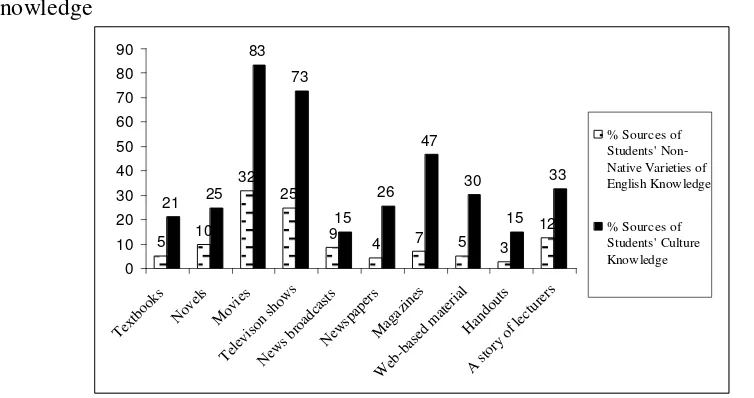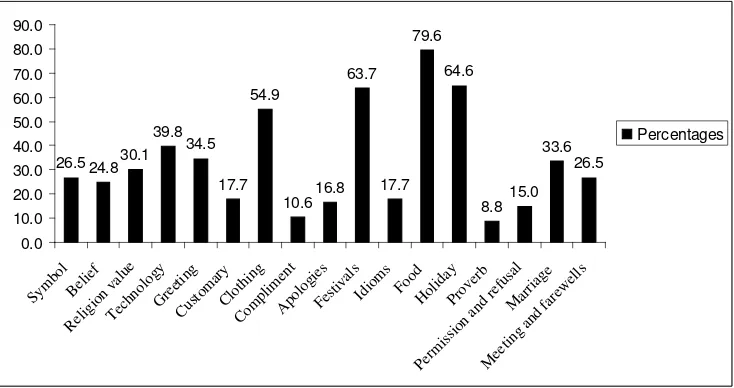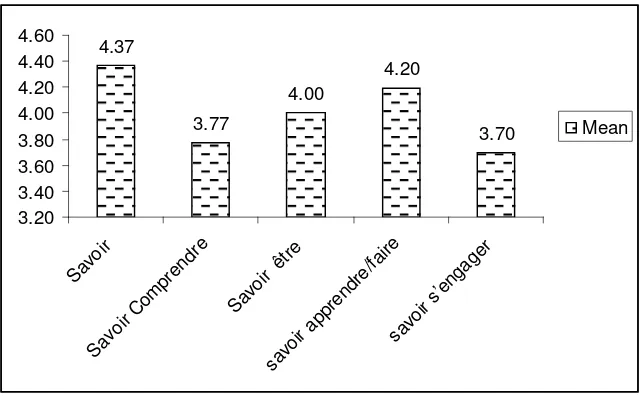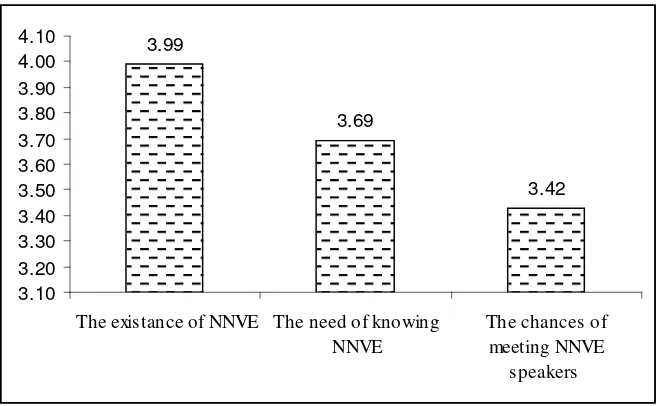NEEDS ANALYSIS OF ENGLISH INTERCULTURAL COMPETENCE FEATURES BELIEVED TO BE IMPORTANT BY EFL STUDENTS AT
MARANATHA CHRISTIAN UNIVERSITY
By
Fenty Lidya Siregar and Henni
Abstract
The present paper aims at discussing what features of English intercultural competence are believed to be important for Indonesian EFL learners to be successful English learners and in an international communication. The research participants are 113 learners currently enrolling in D3 (Diploma Three) English program and English Literature program (BA in English Literature) at Maranatha Christian University. In order to gain data for the present study, a questionnaire containing open and closed questions was administered to the participants. A descriptive statistical analysis was conducted to answer some questions raised in the study. The findings shows that most of the students learn English to be able to communicate with both native speakers of English (such as Americans British, Australians) and non-native speakers of English (such as Malaysians, Singaporeans, Indians) and they think that it is important to gain intercultural competence as well as knowing non-native varieties of English.
Key words: English, communication, intercultural competence, varieties of Englishes
1. Introduction
countries such as Singapore, Malaysia, Thailand, the Philippines and Taiwan. Therefore, there is a big possibility that when Indonesian bankers sit down to discuss business with their Filipino or Thai counterparts, they will use English to communicate (Kirkpatrick, 2006). Thus, it is also possible that the English used in the communication might be influenced by their culture and variety of English. Currently, the Englishes taught and learned in Indonesia are British or American English, both “inner circle” varieties. There is also a presence of Australian English; however, compared to American and British English, Australian English has less prestige except perhaps with students returning from studying there (Lauder, 2008). In other words, most of time in the practice of teaching English, the English cultures taught are only about the major English-speaking nations. It indicates that at this moment Indonesian EFL learners have not been exposed to both non-native varieties of English (NNVE) and their culture which the learners might often face. Hence, they might have a big difficulty to have a successful intercultural communication with other speakers of NNVE.
and Zarate (1994) also challenge the firmly-held assumptions that the aim of foreign language teaching and learning is to imitate the native speaker. They are against that idea as they think that it implies “abandoning one social identity in favour of another, and partly because native speakers do not “know” their culture any more than they can be said to “know” their language. EFL learners will always appear as an inferior language users if they are compared to native speakers of English. Consequently, they will somewhat run the risk of being the weaker part in the conversation (Bryam & Zarate, 1994). In relation to the facts, it can be concluded that the aim of learning English must be attaining intercultural communicative competence (ICC). According to Bryam and Fleming (1998, p12), ICC involves one’s understanding of the differences in interactional norms between different speech communities and his/her ability to “reconcile or mediate between different modes present.” Moreover, according to writers in the fields of World Englishes (WE) such as Kachru, Rajagopalan, and Widdowson, English is not anymore “owned” by any particular culture but it belongs to the world at large; therefore, it is necessary for one to be exposed to non-native varieties so that he/she can truly gain intercultural competence of English (as cited in Cortazzi & Jin, 1999, p. 198 and in Siregar, 2009). It is obvious then, that to perform successfully in situations in which there are cultural differences, EFL learners need to develop intercultural communicative competence (Alptekin, 2002). This situation has indirectly urged the need of increasing the Indonesian EFL learners’ awareness of developing their intercultural communicative competence and learning new varieties of Englishes which they might encounter in the future.
learners in an international communication. What the research tries to find out is formulated in the following research questions:
1. What is the goal of the students in learning English?
2. What features of intercultural competence are believed to be important by the students?
3. How can the EFL teaching and learning be adjusted to support students’ intercultural competence development?
2. Methodology 2.1 Participants
A total of 113 MCU students from six different classes participated in this study. There were 59 males and 54 females. Their average age was between 17 and 25. They were either studying at D3 English Programme or at the English Department.
2.2 Data gathering procedure
To gain data needed for the current research, need analysis questionnaires were distributed in two weeks to 6 different classes. It was done from 18 May until 28 May. It took about 10 to 15 minutes for each participant to answer the questionnaire.
2.3 Data analysis
2.4 Statistical treatment
The data from the questionnaire were analyzed and coded. For part one every answer was noted as one score. For part B, the scores ranged from 1 to 5. Thus, the strongly agree statement would be scored 5, agree statement 4, neither agree or disagree 3, disagree 2, and strongly disagree 1. The statistical analysis was conducted using SPSS. Regarding the answers of the open-ended questions, the answers were also coded and summarized.
3. Result and discussion
Table 1 shows the students’ goal of learning English and their knowledge of NNVE. It can be seen that almost 75 percents of the students learn English to be able to communicate with both native speakers of English (such as Americans British, Australians) and non-native speakers of English (such as Malaysians, Singaporeans, Indians, Thais). There are only 17 percents of the students who learn English to be able to communicate with native speakers of English (examples: American, British, Australian) and less than 9 percents of the students who learn English for varied reasons such as to get a job, a degree, and basic skills of English.
Table 1
The goal of learning English and the knowledge of NNVE
No Part A-Statement F %
1 My goal in learning English is to:
a. be able to communicate with native speakers of English (examples: American
19
16.81 b. be able to communicate with both native speakers of English (such
as Americans British, Australians) and non-native speakers of English (such as Malaysians, Singaporeans, Indians, Thais)
84
74.34
c. other 10 8.85
as Philippines English, Singapore English, Malaysia English, Indian English) before?
a. Yes 46 40.71
b. No 67 59.29
The findings indicate that the students’ goal in learning English is to gain intercultural communicative competence; therefore, there is a need for teachers, language educators, and language policy makers to develop and facilitate learners’ learning to reach their goal. The findings also suggest that some of the current Indonesian students have instrumental motivation. They learn English so that they can gain practical benefits for their future which is a common phenomenon found in an EFL setting (Siregar, 2009; Siregar, 2010). Besides, it can be noticed clearly that there are more students who have not known or learnt NNVE than those who have. Only slightly over 40% of the students have known or learnt NNVE and almost 60% of the students have not. Thus, the findings suggest that although most of the students learn English to be able to communicate with both native and non-native speakers of English, only few of them have known or learnt NNVE. It means there is a need to adjust the current English material to meet the students’ need.
Figure 1. The sources of students’ non-native of English knowledge and culture knowledge
5 10
32 25
9
4 7 5 3
12 21 25 83 73 15 26 47 30 15 33 0 10 20 30 40 50 60 70 80 90 Text books Nove ls Movi es Tele vison s
how s
New s bro
adca sts New spap ers Mag azin es Web -bas
ed m ater
ial Handout
s
A st ory of
lect urer
s
% Sources of Students' Non-Native Varieties of English Knowledge
Figure 1 shows the sources of students’ non-native of English knowledge and culture knowledge. The data show that most students gain the knowledge of culture and non-native varieties of English from movies and television shows. More than 80 percents of the students obtain culture knowledge from movies. There are nearly 75 percents of the students who gain culture knowledge from television shows. Slightly over 30 percents and exactly 25 percents of the students obtain culture knowledge from movies and television, respectively. This finding is similar to the previous finding of Siregar’s research (2008) on Asian graduate students who study in a private university in the Philippines.
The participants of this current study also state that they get most of their culture and NNVE knowledge from movies and television shows. In other words, the current results also suggest that movie and television are found to be effective means to gain the knowledge of culture and NNVE. This finding supports Arthur (1999), who states that films can provide learners with much valuable information, for example, getting to know different cultures and learning about different perceptions toward some phenomena. In other words, movies contain lots of cross-cultural value and offer linguistic diversity and can be used as an effective means in developing students’ IC. Besides, Figure 1 presents that only 15 % of the students get culture knowledge from handouts and less than 5 % of the students know or learn NNVE from handouts. This fact indicates that the current material used in MCU has not adequately provided the students with the knowledge of culture and NNVE. Thus, it is important for MCU English teachers to add some new material which can fulfill the students’ need.
18 17 65
13 34
4 4
1 1 1
0 10 20 30 40 50 60 70 Indi an Phi lippi ne Singap ore Mal aysi an Hongk ong Kor ean Japan
ese Thai Fren
ch
All N NVE
Figure 2 presents the non-native varieties of English that the students are interested learn. It can be noticed that Singaporean and Hong Kong Englishes have higher percentages than other non-native varieties of English. Exactly 65% of the students are interested to learn Singaporean English and almost 35% of the students have an interest to learn Hong Kong English. Surprisingly, less the 15% of the students would like to learn Malaysian English. It might be because Indonesian and Malay languages are almost similar so that the students can simply use Indonesian to communicate with Malaysian. Besides, concerning the reasons for the NNVE to be important to learn, the students mention three points. Firstly, most of the students say that they may travel to those NNVE speaking countries someday in the future. The second reason is that they want to continue their studies in those countries, and the third is they want to do business with the people from those countries in the future.
26.5 24.830.1 39.8 34.5 17.7 54.9 10.6 16.8 63.7 17.7 79.6 64.6 8.815.0 33.6 26.5 0.0 10.0 20.0 30.0 40.0 50.0 60.0 70.0 80.0 90.0 Sym bol Belie f Relig ion v
alue Techn ology Gre etin g Cust omary Clo thing Com plim ent Apo logi es Festiv als Idiom s Food Hol iday Pro verb Per mis sion and refus al Marri age Meet ing
and f arew
ells
Percentages
Figure 3 presents the kinds of culture knowledge that the students are interested in. It can be noticed that most students want to learn about food, holidays, festivals and clothing. Almost 80% of the students show their interest in learning about food, nearly 75% of the students want to know about holidays, more than 63% of the students are interested in learning about festivals, and almost 40% of the students would like to learn about clothing. On the other hand, the part of culture which obtains the smallest percentage is proverbs: less than 10 percents of students want to learn proverbs. It seems that the students are more interested in knowing more about the culture that they can appreciate empirically through their five senses. They are not really interested in pragmatic and social values of different cultures.
4.37 3.77 4.00 4.20 3.70 3.20 3.40 3.60 3.80 4.00 4.20 4.40 4.60 Sav oir Sav oir C
om prendr
e
Sav oir ê
tre
sav oir a
ppr endr
e/fai re
sav oir s
’enga ger
Mean
on the basis of explicit criteria of perspectives, practices and products in one’s own and other cultures and countries (Byram, 2003, p. 62). Both of them gain the scores more than 3.7 and exactly 3.7 respectively. Therefore, these mean scores suggest that the students agree with Cortazzi’s and Jin’s (1999) statement about the importance of intercultural competence for successfully involving in an intercultural communication.
Figure 5. The existence and knowledge of NNVE, and chance of meeting NNVE speakers
3.99
3.69
3.42
3.10 3.20 3.30 3.40 3.50 3.60 3.70 3.80 3.90 4.00 4.10
The existance of NNVE The need of knowing NNVE
The chances of meeting NNVE
speakers
statements of Kachru, Rajagopalan, and Widdowson about the need of exposing EFL learners to NNVE to help them become intercultural speakers (as cited in Cortazzi & Jin, 1999 p. 198 and in Siregar, 2009).
4. Conclusion, implications and suggestions
Based on the above discussion, it can be concluded that the students’ goal in learning English is not to gain communicative competence, but to gain intercultural communicative competence. Most of the students believe that intercultural competence is important to acquire. The students are also aware that English has some varieties and they are interested in learning some of the NNVE such as Singaporean and Hong Kong English. However, they still have limited sources to get knowledge of culture and NNVE. They also claim to have gained most of their culture and NNVE knowledge from movies and TV shows. Thus, English teachers in MCU can make use of movies and TV shows more in their teaching especially when exposing NNVE together with their related cultures to their students.
NNVE as they may get a chance to interact with NNVE speakers more than with native speakers of English.
In relation to the present EFL teaching in Indonesia, the findings suggest that there should be some adjustments made in English teaching especially in MCU English teaching. The adjustments can be done in the curriculum and will surely affect the objectives of each lesson, choices of material, and other related things. The adjustments should also enable teachers to produce Indonesian intercultural speakers. In other words, Indonesian EFL teaching should be able to provide students with “a willingness to relativise one’s own values, beliefs and behaviours, not to assume that they are the only possible and naturally correct ones, and to be able to see how they might look from the perspective of an outsider who has a different set of values, beliefs and behaviours” (Byram, Nichols, & Stevens 2001, p.5). With such a goal, Kramsch (1998) suggests that “foreign language pedagogy must go beyond learning ‘about’ a culture’s rituals and histories and engage the learner in a reflective experience of the dialectic between language and culture.” He also says, “The responsibility of the language teacher is to teach culture as it is mediated through language, not as it is studied by social scientists and anthropologists” (p. 31).
REFERENCES
Alptekin, C. (2002). Towards intercultural commu-nicative competence in ELT. ELT Journal, 56 (1): 57–64.
Arthur, P. (1999). Why use video? A teacher’s perspective. VSELT, 2(4), 4.
Byram, M. (2003). On Being “Bicultural and Intercultural.” In G. Alread, M. Byram & M. Fleming (Eds.). Intercultural Experience and Education (pp. 50-66). Clevedon: Multilingual Matters.
Byram M. & Fleming, M. (1998). Culture and language learning. In M. Byram and M. Fleming (Eds.), Language learning in intercultural perspective: Approaches through drama and ethnography (pp. 1-9). Cambridge: Cambridge University Press.
Byram, M., Nichols, A., & Stevens, D. (Eds.), (2001). Developing intercultural competence in practice. Tonawanda, NY: Multilingual Matters, Ltd.
Byram, M. & G. Zarate (1994). Definitions, objectives and assessment of sociocultural competence. Strasbourg: Council of Europe.
Coperías MJ (2002) Intercultural communicative competence: A step beyond communicative competence. ELIA, Estudios de Lingüística Inglesa Aplicada 3, 85–102
Cortazzi, M & Jin, L. (1999). Cultural mirrors. In E. Hinkel (Ed.), Cultural in second language teaching and learning (pp. 196- 219). Cambridge: Cambridge University Press.
Kramsch, C. (1998). The privilege of the intercultural speaker. In M. Byram and M. Fleming (Eds), Language learning in intercultural perspective: approaches through drama and ethnography, 16-31. Cambridge: Cambridge University Press. Kirkpatrick, A. (2006). Teaching English across cultures. What do English language
teachers need to know how to teach English. Retrieved from http://www.englishaustralia.com.au/index.cgi?E=hcatfuncs&PT=sl&X=getdoc&L ev1=pub_c07_07&Lev2=c06_kirkp
Launder, A. (2008). The status and the function of English in Indonesia: A review of key factors. Makara Sosial Humaniora, 12(1), 9-20.
Siregar, F. L. (2009). Needs analysis of communicative competence features believed to be important by selected foreign graduate students at De La Salle university- manila. Lingua Cultura, 2(1), 1-11.
Siregar, F. L. (2008). Needs analysis of intercultural competence features believed to be important by selected foreign graduate students at De La Salle university- Manila. Unpublished manuscript.
Siregar, F. L. (2010). The role of motivation and language learning strategies in Indonesian EFL students’ language learning: A study of engineering students at Institut Teknologi Harapan Bangsa. Paper presented at Asian EFL Journal International Conference, Taichung, Taiwan.





